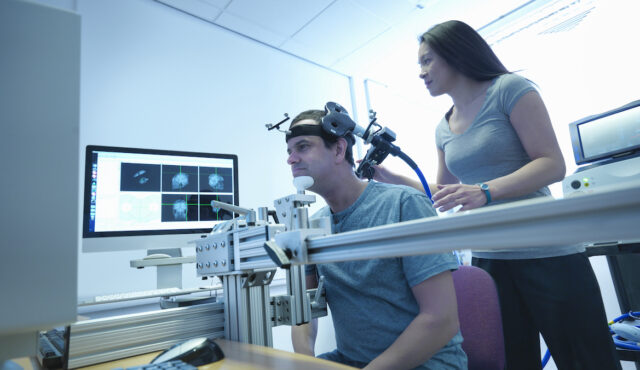Depression affects five percent of the global population. While that may not sound like much, in reality, it comes out to roughly 394 million people, making it one of the most common mental health disorders. Thanks to its prevalence, doctors and therapists all over the world have worked to come up with an array of solutions. While daily medications, therapy, and nourishing self-care practices are the most popular methods for managing and preventing depression symptoms, Transcranial Magnetic Stimulation (TMS) exists, too—though, it’s considerably less talked about.
“TMS is currently considered by many to be one of the most valid therapeutic options—either alone or in combination with drugs and psychotherapy—to alleviate symptoms of numerous neurological and psychiatric conditions,” says neurologist Antonello Bonci, MD, of GIA Miami, who specializes in the practice.
What is transcranial magnetic stimulation?
TMS is a form of noninvasive brain stimulation that’s virtually painless and notably beneficial for those living with major depressive disorder, as well as other psychiatric conditions. Although it’s been around since the mid ’80s, it wasn’t until the late ’00s that it became more mainstream.
“TMS was brought to the clinic for the first time in 1985. A few years later, functional neuroimaging studies revealed that [patients with] depression had a low level of activation of specific areas of the brain, including the left dorsolateral prefrontal cortex,” Dr. Bonci says. “In 1995, a clinical trial applied TMS to stimulate the left dorsolateral prefrontal cortex, to reactivate its function in patients with major depression. By the end of the first week of treatment, patients reported an important improvement of the depressive symptoms.”
For the next decade, doctors and scientists experimented with TMS to determine its parameters and key benefits. “In 2008, after hundreds of clinical trials, the U.S. Food and Drug Administration (FDA) approved TMS for the treatment of major drug-resistant depression,” Dr. Bonci says.
Logistically, the Mayo Clinic defines TMS as “a procedure that uses magnetic fields to stimulate nerve cells in the brain to improve symptoms of major depression.” The magnetic pulses are delivered via an electromagnetic coil that’s placed against the scalp in an area that coordinates with the region of the brain responsible for mood regulation. According to Dr. Bonci, TMS treatments typically last between three and 20 minutes. Courses of treatment typically include daily sessions for about four to six weeks.
The benefits of transcranial magnetic stimulation
While TMS was first explored for its ability to address depression symptoms, over the years, it has proven to be effective for managing a number of mental health conditions. “It is now FDA-approved for the treatment of clinical depression, obsessive compulsive disorders, [and] smoking cessation,” says Dr. Bonci, adding that clinical studies have also shown it can effectively treat anxiety disorders, post traumatic stress disorder, and substance use disorders. (In Europe, it is approved to treat addiction.)
TMS can also significantly reduce the impact of chronic stress. “Chronic stress can lead to both short- and long-term changes of our brain circuit’s activity, interfering with cognition, attention, and memory,” Dr. Bonci says. “Several scientific studies have demonstrated that animals experiencing prolonged stress have less activity in those brain areas controlling higher-order functions, such as the prefrontal cortex, and an hyperactivation of primitive parts of the brain, such as amygdala and the limbic system.” When specific magnetic pulses are applied to these areas, they can help essentially rewire the brain.
“TMS can help our brain circuits to better function, reducing anxiety, insomnia, and depression,” Dr. Bonci says. “This technique produces its effects by re-balancing the activity of brain regions that are correlated with symptoms of stress. Thus, we now have a powerful tool that in combination [with] conventional treatments, such as psychotherapy and medications, can help people to overcome their stress-triggered symptoms, such as anxiety, depression, insomnia and addictions.”
Additional proven TMS benefits include:
Furthermore, Dr. Bonci says that not only is TMS noninvasive, it doesn’t require anesthesia or hospitalization, it’s well-tolerated, requires no downtime, and has few side effects. (The Mayo Clinic lists scalp discomfort, headaches, facial twitching and lightheadedness as possibilities, noting they decrease over time.) “TMS therapy also works well, and synergistically with other types of talk therapies and treatments,” he adds.
The best candidates for transcranial magnetic stimulation
Due to TMS’ many benefits, it’s a treatment that can help many people. “People struggling with depression, anxiety, OCD, insomnia, PTSD, addictions, long-Covid symptoms, dementia, recovery post-stroke, and Parkinson’s should all consider talking with a physician of their choice, and asking if TMS is for them,” Dr. Bonci says.
Generally, though, TMS is thought to be the proper avenue of alleviation for those who haven’t had success with other modalities. “TMS is usually chosen by individuals that have tried medications without seeing significant benefits, by individuals who had benefits with medications but experience intolerable side effects, or by those who prefer not to take medications,” Dr. Bonci says.
Keep in mind
Although TMS is noninvasive and doesn’t require any downtime, it’s not a one-stop, single-treatment solution. “As per FDA guidelines, usually patients receive 36 TMS sessions when it comes to, for example, treating depression,” Dr. Bonci says. “However, it also depends on the condition treated.” That said, he points out that those with anxiety, insomnia, addiction and depression often notice significant improvement within just a few days of the initial TMS treatment.











